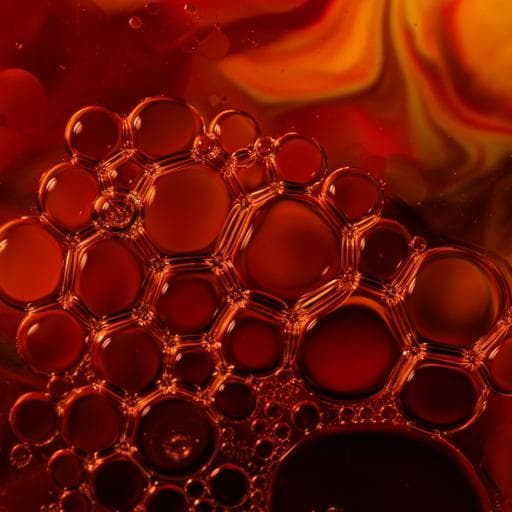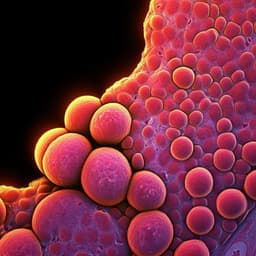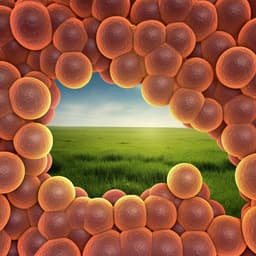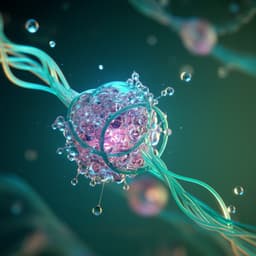
Food Science and Technology
Muscle-derived fibro-adipogenic progenitor cells for production of cultured bovine adipose tissue
R. G. J. Dohmen, S. Hubalek, et al.
Discover how fibro-adipogenic progenitor cells (FAPs) can revolutionize cultured meat by mimicking traditional beef fat in flavor and texture. This groundbreaking research, conducted by a team of experts including Richard G. J. Dohmen and Sophie Hubalek, unveils the potential of FAPs for enhancing cultured fat production.
~3 min • Beginner • English
Introduction
The study addresses the need for cultured fat to complement cultured muscle in order to accurately mimic traditional meat’s flavour, texture, and mouthfeel. While cultured meat efforts have focused primarily on skeletal muscle derived from satellite cells, intramuscular and subcutaneous fat significantly influence palatability, with characteristic lipid profiles and melting behavior that are difficult to replicate using plant fats. Existing adipose tissue engineering approaches face challenges including limited adipogenic maturity, reliance on animal-based scaffolds, and poor scalability. Fibro-adipogenic progenitor cells (FAPs), interstitial mesenchymal progenitors resident in skeletal muscle and marked by PDGFRα, are the predominant source of intramuscular adipocytes in vivo and may offer advantages for cultured fat production. The study’s purpose is to isolate bovine FAPs concurrently with satellite cells, characterize them, expand them at scale, and differentiate them into mature adipocytes within edible 3D hydrogels to generate cultured fat that mimics traditional beef fat in lipid composition and sensory attributes.
Literature Review
Prior work in cultured meat has largely emphasized muscle tissue formation using satellite cells and animal-free scaffolds to improve texture and protein expression. However, fat tissue contributes essential sensory qualities and has distinct lipid profiles that are challenging to emulate with plant oils. Reported adipose tissue engineering protocols often use animal-derived scaffolds, achieve limited adipogenic maturity, and are not readily scalable. Multiple cell types can undergo adipogenesis in vitro, including MSCs from bone and fat, de-differentiated fat (DFAT) cells, ESCs, iPSCs, and occasionally satellite cells. In vivo, intramuscular adipocytes derive mainly from PDGFRα+ FAPs, identified across species including bovines. FAPs support muscle regeneration and contribute to fibrosis/adipose deposition under pathology, and their role suggests potential for accurate recapitulation of intramuscular fat in vitro. Edible, scalable hydrogels such as alginate microfibres have been explored for adipocyte culture, but previous approaches often relied on animal-based materials or lacked maturation and scale. These contextual findings underpin the rationale to leverage bovine muscle-derived FAPs and edible 3D biomaterials for cultured fat production.
Methodology
Sample sourcing: Fresh bovine semitendinosus muscle and subcutaneous fat were obtained from an abattoir under Dutch guidelines (Category 3 material). Cell isolation: Minced muscle was digested with collagenase (1 h, 37 °C), filtered (100 µm), subjected to ACK lysis, resuspended in growth medium (GM), and filtered (40 µm). FACS: After 72 h pre-culture on bovine collagen I (2.5 µg/cm²), cells were immunolabeled and sorted on a FACSAria II. CD31−/CD45− cells were split into CD29+/CD56− (FAPs) and CD29+/CD56+ (satellite cells, SCs). Sorting parameters were set using unstained controls; purity was routinely checked. Cell culture and differentiation: Cells were expanded on collagen-coated flasks in GM (seeding 2 × 10³ cells/cm²). Myogenic differentiation: cells plated at 5 × 10⁶ cells/cm² on 0.5% Matrigel in GM for 24 h, then switched to myogenic differentiation medium; assessed after 96 h. Adipogenic differentiation (2D): cells seeded at 4 × 10⁶ cells/cm² in GM, after 24 h switched to adipogenic differentiation medium (ADM) containing four inducers; after 3 days, continued ADM with rosiglitazone and insulin only; media changes every 3 days; controls lacked inducers. 3D adipogenic microfibres: FAPs were encapsulated in 0.5% high-viscosity alginate (3 × 10⁷ cells/mL), gelled in 66 mM CaCl₂/10 mM HEPES, washed, and cultured in serum-free ADM on a shaker (75 rpm, 37 °C, 5% CO₂) with media exchanges every 3–4 days. Immunostaining and imaging: For 2D, cells were fixed and stained with Hoechst and BODIPY; myogenic assays also stained for desmin. For 3D fibres, fixation included CaCl₂/HEPES; fibres were stained with Hoechst and BODIPY, and immunolabeled for PLIN1 and ACC as needed. Imaging used an ImageXPress Pico or Leica TCS SP8 confocal. Quantification: Nuclei and BODIPY positivity quantified by MetaXPress (2D); 3D lipid volume per cell quantified from confocal stacks using a custom Python script (three images per sample). Gene expression: RNA extracted with E.Z.N.A. kits, reverse-transcribed (iScript), and RT-qPCR performed with SYBR Green; normalization to housekeeping genes (B2M, RPL19, RPLP0 for myogenic; RPL19, RPLP0, UXT for adipogenic); fold-changes calculated versus specified controls. RNA-seq: Libraries (TruSeq stranded mRNA) sequenced on NextSeq 500 (75 bp single-end). Reads aligned with STAR to bosTau9 (ARS UCD1.2.98); counts by featureCounts; PCA on 500 most variable genes; differential expression by limma with cutoffs |log2FC| > 1, FDR < 0.05. Flow cytometry: FAPs and SCs stained for PDGFRα-AF647, ITGA5-APC, CD14-APC, CD61-APC, combined with CD56-PE; analyzed on MACSQuant10 with unstained controls; analysis in FlowJo. Microcarrier expansion: Cytodex 1 microcarriers hydrated and preconditioned; cells seeded at 1.5 × 10³ cells/cm² in 30 mL spinner flasks at 60 rpm; 50% media exchange every 48 h; images captured; counts by NucleoCounter NC-200. Harvesting used TrypLE and filtration. Metabolite tolerance assessed via lactate and ammonium spiking. SEM: Samples fixed in formaldehyde/glutaraldehyde, rinsed, ethanol-dehydrated, HMDS-dried, gold sputter-coated, imaged on JEOL JSM-IT200. Lipidomics: 10–30 mg samples extracted via modified Bligh-Dyer; analyzed by HILIC LC-MS/MS; normalization to protein content; peaks integrated with MultiQuant; isotopic corrections via Molmass; quantification per Lipidomics Standards Initiative. Sensory analysis: Three unblinded volunteers evaluated pan-fried samples (3–5 min, no oil) of cultured fat (frozen storage), subcutaneous fat, and empty alginate; scored appearance, aroma, taste, and texture under EC ethics guidance. Statistics: Student’s t-test for two-group comparisons; one-way or two-way ANOVA with Bonferroni post-hoc for multiple groups/variables; Prism 9.1.0.
Key Findings
• FAP isolation and identity: A CD29+/CD31−/CD45−/CD56− population from bovine muscle was isolated by FACS at high yields (~10⁵ cells per gram of muscle) alongside satellite cells. FAPs exhibited elevated PDGFRA and reduced PAX7 and NCAM1 compared to SCs by RT-qPCR. RNA-seq showed clear clustering by cell type (PCA) and 3898 differentially expressed genes (27.8% of identified genes; |log2FC| > 1, FDR < 0.05), with adipogenic progenitor genes (PPARG, SCARA5, PDGFRA) upregulated in FAPs and myogenic markers (PAX7, MYOD1, MYOG, NCAM1) upregulated in SCs. Flow cytometry confirmed differential surface markers (PDGFRα, ITGA5, CD14, CD61). • Lineage potential in 2D: Under myogenic conditions (96 h), SCs formed desmin+ myotubes with a fusion index of 53.8% (SD 2.3%) vs 2.4% (SD 0.5%) for FAPs. Under adipogenic conditions (14 days), FAPs showed markedly greater lipid accumulation than SCs (BODIPY+ cells: 53.0% SD 1.1% vs 3.2% SD 0.7%) and strong induction of adipocyte genes (e.g., FABP4, ADIPOQ, TRARG1, CIDEC). • 3D differentiation in edible hydrogels: In alginate microfibres, FAPs differentiated into mature adipocytes with unilocular lipid droplets by Day 28, strong PLIN1 and ACC staining, and significant increases in lipid volume per cell under ADM. Adipogenic gene expression in 3D exceeded 2D levels by comparable timepoints. Some spontaneous differentiation occurred without inducers; donor-to-donor variation in lipid accumulation was observed. • Proliferation and scale-up: In planar culture, FAPs exceeded 30 cumulative population doublings with stable morphology. Differentiation capacity declined with passaging (lower lipid volume per cell at 25 PDs vs 5–15 PDs). In spinner flasks on Cytodex 1, FAPs expanded 26-fold over 110 h with no lag phase and an average doubling time of 22.6 h (SD 2.0 h). Cells tolerated metabolite accumulation up to ~20 mM lactate and ~3 mM ammonium and retained adipogenic potential post-harvest for 3D differentiation. • Sensory and lipidomics: Cultured fat visually resembled beef fat but with a more yellow hue; SEM showed enlarged cells at Day 28 and less ECM than subcutaneous fat. Upon pan-frying, cultured fat left an oily residue and released some water; a three-person panel reported creamy texture and a discernible beefy flavor. Lipid content (normalized to protein) increased significantly over differentiation. Triglyceride profiles of cultured fat converged toward those of bovine fat and muscle over time. After 28 days, cultured fat had lower C16:0 and C18:2, higher C18:1, and an increased proportion of MUFAs, with reduced saturated and polyunsaturated fatty acids; acyl chain lengths were similar to controls.
Discussion
The findings demonstrate that bovine muscle-resident FAPs are a distinct progenitor population from satellite cells and are particularly well-suited for adipogenic differentiation relevant to cultured fat production. Isolation by a simple FACS strategy enables concurrent procurement of both adipogenic (FAPs) and myogenic (SCs) cell types from a single biopsy, aligning with integrated cultured meat bioprocesses. In vitro, FAPs showed minimal myogenesis and robust adipogenesis, especially within edible alginate microfibres where cells attained mature, unilocular adipocyte morphology and high adipogenic gene expression. Scalable expansion on microcarriers with short doubling times and sustained differentiation capacity post-expansion supports feasibility for upscaling. Lipidomic convergence toward bovine fat triglyceride profiles and a sensory profile characterized by creamy, beef-like flavor indicate that FAP-derived cultured fat can mimic critical sensory and compositional attributes of traditional fat. These results address key hurdles in cultured fat by using an edible, scalable scaffold and a physiologically relevant adipogenic progenitor, and suggest potential for co-culture with SCs and for engineering fatty acid composition to optimize nutrition and flavor.
Conclusion
Bovine muscle-derived FAPs can be efficiently isolated, expanded, and differentiated into mature adipocytes within edible alginate microfibres to produce cultured fat that closely resembles traditional beef fat in structure, lipid composition, and sensory properties. The work introduces a practical, scalable approach to sourcing adipogenic cells directly from muscle, facilitating integration with muscle cell production for complex cultured meat constructs. Future work should focus on maintaining adipogenic competence over extended passaging, optimizing fully food-compatible and serum-free media, increasing ECM deposition and tissue complexity (potentially via controlled fibroblastic differentiation or co-culture), refining bioprocess parameters to increase cell densities in bioreactors, and conducting larger, blinded sensory evaluations. Engineering targeted lipid profiles (e.g., enhancing PUFA or essential fatty acids) is a promising direction for tailoring health and flavor attributes.
Limitations
• Differentiation capacity declined with cell age/passaging (reduced adipogenesis at higher population doublings). • Donor-to-donor variability affected adipogenic outcomes. • Cultured fat exhibited less native ECM structure than subcutaneous fat by SEM. • Sensory analysis was limited to a small, unblinded panel (n=3). • Some spontaneous differentiation occurred without inducers, indicating heterogeneity or baseline adipogenic drift. • Current media included components (e.g., FBS during proliferation; specific adipogenic inducers) that may not be fully food-compatible; serum-free, food-grade formulations require development. • Color differences (more yellow hue) relative to traditional fat suggest compositional differences (e.g., carotenoids) that may need control. • Long-term stability of phenotype and full assessment of large-scale bioprocess performance remain to be established.
Related Publications
Explore these studies to deepen your understanding of the subject.







